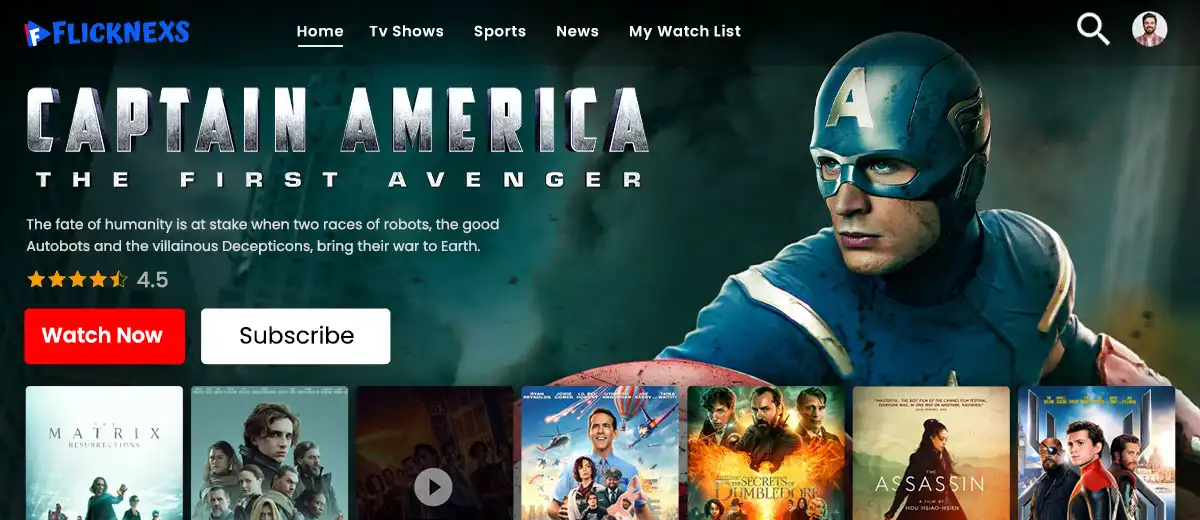Video streaming services have become a crucial for entertainment, and OTT content providers are leading the way. In OTT content providers there are so many options are available, it can be challenging to choose the best one for your needs. In this article, we’ll explore what is OTT content providers and how does it works etc…
What is an OTT Content Providers?
OTT content providers are internet-based video streaming services that offer movies, TV shows, and original content accessible on various devices, bypassing traditional cable and satellite TV providers. Examples include Netflix, Amazon Prime Video, Hulu, Disney+, HBO Max, Apple TV+, YouTube TV, and Sling TV.
Importance of OTT content providers
OTT (over-the-top) content providers are becoming increasingly important in the media industry as more and more viewers shift away from traditional cable and satellite TV in favor of on-demand streaming services. These providers offer a wide range of content, including movies, TV shows, and original programming, that can be accessed anytime, anywhere, and on a variety of devices.
They also offer personalized recommendations, user-friendly interfaces, and flexible pricing plans, making it easier for viewers to find and watch the content they want.
As a result, OTT content providers are transforming the way people consume media and are playing a major role in shaping the future of entertainment.
How does OTT content Providers work
Content Delivery Networks (CDNs):
OTT content providers rely on CDNs to deliver their content to viewers worldwide. CDNs help to reduce latency, increase content availability, and improve the viewing experience by caching content on servers located closer to the viewer. Examples of CDNs used by OTT content providers include Amazon CloudFront, Akamai, and Cloudflare.
Streaming Protocols:
It uses streaming protocols to deliver their content over the internet. Streaming protocols are responsible for breaking down the content into smaller segments and delivering them in a format that can be played back in real-time. Popular streaming protocols used by OTT content providers include HTTP Live Streaming (HLS), Dynamic Adaptive Streaming over HTTP (DASH), and Smooth Streaming.
Content Licensing:
OTT content providers require licenses to distribute content from content owners. Content licensing agreements determine the rights and restrictions on how the content can be distributed, monetized, and accessed by viewers. Examples of content licensing agreements include Netflix’s agreements with production companies and studios for original and licensed content, Hulu’s agreements with TV networks for live and Video on-demand content, and Amazon Prime Video’s agreements with content owners for exclusive streaming rights.
Read more : How OTT Technology Is Shaping The Future Of Entertainment
Popular OTT Content Providers and Its Benefits :
| OTT Content Provider | What is it? | Benefits |
| Netflix | Netflix is one of the most popular OTT content providers in the world, offering a vast library of movies, TV shows, documentaries, and original content. | 1. Convenient access to a vast library of content on multiple devices. 2. Affordable subscription plans. 3. On-demand access to a diverse range of movies, TV shows, and original content. |
| Amazon Prime Video | Amazon Prime Video is a streaming service offered by Amazon, which is included in the Amazon Prime subscription. | 1. Convenient access to a diverse range of content, including exclusive Amazon Originals. 2. Bundled with Amazon Prime membership, which offers additional benefits such as free shipping and access to Prime Video, Prime Music, and more. 3. On-demand access to a wide variety of movies, TV shows, and original content. |
| Hulu | Hulu is a streaming service that offers a combination of current and classic TV shows, movies, and original content. | 1. Access to a vast library of TV shows, including current episodes of popular series. 2. Affordable subscription plans with limited commercials or ad-free options. 3. Exclusive original content. |
| Apple TV | Apple TV is a streaming service offered by Apple that provides access to movies, TV shows, and original content. | 1. Exclusive access to Apple Originals, including TV shows and movies. 2. Seamless integration with other Apple devices and services. 3. High-quality content with a focus on premium production values. |
| Disney+ | A subscription-based streaming service that offers a wide range of movies, TV shows, and original content from Disney, Pixar, Marvel, Star Wars, and National Geographic. | 1. Exclusive access to a vast library of Disney, Pixar, Marvel, Star Wars, and National Geographic content. 2. Family-friendly content suitable for all ages. 3. On-demand access to a diverse range of movies, TV shows, and original content. |
Challenges of OTT Content Providers
Content Availability:
One of the challenges faced by OTT content providers is the availability of content. Content licensing agreements and exclusive deals can restrict the availability of popular content on certain platforms, leading to disappointment among fans, as seen with the exclusive availability of the TV show Friends on Netflix for a limited time.
Content Licensing:
Another challenge is the complex nature of content licensing, as content rights may vary from region to region, making it difficult for providers to offer the same content worldwide. Additionally, licensing fees can be expensive, which can limit the amount of content a provider can offer. For example, HBO Max has exclusive rights to popular TV shows like Game of Thrones and The Sopranos, but it comes at a higher subscription cost compared to other platforms.
Bandwidth:
One of the technical challenges for OTT providers is delivering high-quality content without buffering or interruption, which requires high bandwidth. This can be a challenge in areas with poor internet infrastructure, resulting in poor user experience. For example, users in rural areas may face buffering issues when streaming high-quality content on platforms like Netflix.
Competition:
The market for OTT content providers is highly competitive, with new players entering the market regularly. This can make it difficult for providers to attract and retain subscribers, as viewers have more options to choose from. For example, the launch of Disney+ in 2019 caused a significant disruption in the market, as it offered exclusive content from popular franchises like Star Wars and Marvel.
Conclusion
As an OTT content provider, comprehending the industry landscape and recognizing the factors that lead to success are vital. It’s crucial to stay current with evolving trends and technologies for sustained prosperity. While establishing a robust brand and cultivating a loyal audience requires dedication and time, with the right strategy, achieving your goals as an OTT content provider is attainable.
Remember to always prioritize high-quality content and user experience, and be open to feedback and constructive criticism from your audience. With a clear vision and a commitment to excellence, you can create a successful and thriving OTT content business.
Frequently Asked Questions
1. How do I sign up for an OTT content provider?
To sign up for an OTT content provider, you can usually visit their website or download their app and create an account with your email address and payment information.
2. Can I cancel my subscription at any time?
Yes, you can usually cancel your subscription at any time by logging into your account and following the cancellation process outlined by the OTT content provider.
3. Do OTT content providers offer free trials?
Many OTT content providers offer free trials to new users, ranging from a few days to a few weeks, to give you a chance to test out their service before committing to a paid subscription.
4. Can I share my OTT account with friends and family?
Sharing your OTT account with friends and family is usually against the terms of service of most providers, and could result in your account being suspended or terminated. It is always best to check the specific guidelines of your OTT provider before sharing your account.
5. Do I need high-speed internet to access OTT content?
Accessing OTT content usually requires a stable internet connection, with high-speed internet recommended for the best streaming experience.
6. What happens if I experience buffering while streaming?
If you experience buffering while streaming, it could be due to a variety of factors such as slow internet connection or network congestion. To improve your streaming experience, try reducing the video quality, closing other programs or devices that are using the internet, or upgrading to a higher internet speed plan.



Leave a Reply